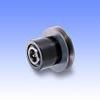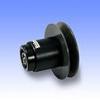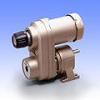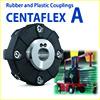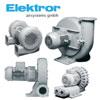P(AP) ModelThe P (AP) model is a VARI-DIA pulley with standard V-belt that changes the rotation speed by moving the mounting motor to vary the pitch diameter of the belt hung on the pulley forcedly. Mounting is easy by using an adapter. And unique cam mechanism prevents slips. Speed can be changed without changing the center distance in combination with the AP model to use the P model on the driven side.
12 Miki Pulley Belt Speed Change Drive
PL ModelThe PL model is a VARI-DIA pulley with standard V-belt that is used by mounting on the motor. A large speed change ratio can be taken up to 1:24 (PL-210). Applicable motors are 0.2kW to 1.5kW (4-pole) and 4 sizes are in the lineup.
PK ModelThe PK model is a VARI-DIA pulley with wide-width speed change belt that is used by mounting on the motor. A large speed change ratio can be taken, and a large transmission capacity is also assured. Applicable motors are 0.4kW (4-pole) to 18.5kW (6-pole) and 6 sizes are in the lineup.
PF ModelThe PF model is a VARI-DIA pulley with wide-width speed changer belt that is used by mounting on the motor. A large speed change ratio can be taken, and a large transmission capacity is also assured. Due to the optimum double swinging design of the pulley, the belt running line is maintained always constant and a long operating life is assured. Applicable motors are 0.4kW to 3.7kW (4-pole) and 4 sizes are in the lineup.
Motor Slide BaseA motor slide base for moving the set motor during speed change of the VARI-DIA pulley. Speed can be easily changed by setting the motor-mounted VARI-DIA pulley on the slide base and turning the handle to change the center distance between the motor and driven side.
Intermediate Pulley(L,U,T Model)An intermediate-type variable speed drive is a speed change pulley used between the motor and machine. Two fixed pulleys (cone) are set at both ends of the sleeve and a moving pulley (cone) is set between them. Speed is changed by moving the pulley to the thrust direction to change the pitch diameters of the motor-side and the machine-side intermediate pulleys antagonistically. The L model with lever-operated speed change, U model with handle-operated speed change and T model for user-defined design are available.
When turning the handle of the motor-side speed changer, the width of the speed change pulley will change. By varying the pitch diameter of the speed change belt, the pitch diameter of the machine-side speed change pulley will follow to change the rotation speed. The PDS model is a belt-type stepless speed change drive that is incorporated directly into machines to save space. There are 6 sizes from 0.2kW to 3.7kW (4-pole) of transmission capacity.
The PDC model is a non-stage speed change unit combining a speed changer of the PDS model, motor and driven shaft on the bed. It is a very simple unit suitable for a used-defined design. There are 6 sizes with the motor output 0.2kW to 3.7kW (4-pole).
PDG ModelThe PDG model is a non-stage speed change unit combining a speed changer of the PDS model, motor and worm reducer on the bed. Various applications such as changing the motor to a brake motor, setting the reducer output shaft upward or using a two-speed worm reducer are available except the standard PDG-BSN model. For the PDG-BSN model, the motor output of 0.2kW to 3.7kW (4-pole) and the reducer rate of 1/10 to 1/60 are available.
ANS ModelANS model is a belt-type stepless speed change drive. When turning the handle of the motor-side speed changer, the width of the speed change pulley will change. By varying the pitch diameter of the speed change belt, the pitch diameter of the machine-side speed change pulley will follow to change the rotation speed. Instead of the original coil spring, a disc spring with constant-pressure load is used for the machine-side pulley that follows the pitch diameter of the motor-side pulley. Due to the disc spring, the transmission efficiency is increased, and a stable variable-speed operation becomes possible. This model is incorporated directly into machines to save space. There are 6 sizes from 0.2kW to 3.7kW of transmission capacity. Each of them has a transmission ratio of 1:4.
AHS ModelThe AH series are a box unit combinable with a conduction equipment such as electromagnetic clutch and brake or motor based on the belt-type stepless speed changer. The AHS model is an intermediate belt speed change drive unit that can be mounted between machines or motor and machine. By selecting the input rotation, an optimum rotation for the machine can be obtained. The output shaft is a through shaft and two machines can be operated proportionally at an optimum ratio. An electromagnetic clutch and brake can be integrated into the driven function (AHS-B model) based on the AHS-A model. Complex controls such as high-frequency start, stop, or inching are available. Select the appropriate model in accordance with the use conditions.
AHM ModelThe AH series are a box unit combinable with a conduction equipment such as electromagnetic clutch and brake or motor based on the belt-type stepless speed changer. The AHM model is a unit integrating a motor and speed changer. An electromagnetic clutch and brake can be integrated into the driven function based on the AHA-A model. Complex controls such as high-frequency start, stop or inching are available. 6 sizes with the motor output 0.2kW to 3.7kW are available.
It is a one-way clutch non-stage speed changer that is operable from zero rotation to maximum rotation instantaneously. Speed change is easy with the easy-to-move lever. The unique structure that transmits the rotation by the link and one-way clutch mechanisms is compact and lightweight, and a large speed change ratio at 1:12 can be taken. Also, there is no limit for the mounting direction. Stand-alone speed changer and speed changer with motor are available.
ANW ModelANW is a model combining a motor and worm reducer with the ANS model speed changer. By the speed change mechanism, an optimum output rotation speed can be obtained. A large variety of shapes such as vertical or horizontal type, or upward output shaft allows easy installation design. The motor output of 0.2kW to 3.7kW (4-pole) with transmission ratio of 1:4 and reducer ratio of 1/10 to 1/60 are available.
ANG ModelThe ANG is a model combining a motor and co-axial reducer with the ANS model speed changer. By the speed change mechanism, an optimum output rotation speed can be obtained. Due to the unlubricated construction of the co-axial reducer, no maintenance is required, which allows easy installation design. The motor output of 0.2kW to 1.5kW (4-pole) with transmission ratio of 1:4 and reducer ratio of 1/5 to 1/80 are available.
ACW ModelThe ACW is a model combining an electromagnetic clutch and brake, motor and worm reducer with the ANS model speed changer. It has a compact design with the electromagnetic clutch mounted on the driven-side speed change pulley and the electromagnetic brake mounted on the worm reducer input shaft. Combination of a worm reducer and electromagnetic clutch and brake produces an optimum output rotation speed. Start-stop, positioning, inching or intermittent operation can be easily performed. The motor output of 0.2kW to 3.7kW (4-pole) with transmission ratio of 1:4 and reducer ratio of 1/10 to 1/60 are available.
ANB ModelThe ANS is a model combining an electromagnetic clutch-brake unit and motor with the ANS model speed changer. Combination of an electromagnetic clutch and brake unit allows frequent start-stop, positioning, inching or intermittent operation at an optimum output rotation speed. The motor output of 0.4kW to 1.5kW (4-pole) with transmission ratio of 1:4 are available.
DC Motors
The MIKI PULLEY DC motor is widely used in every field of industry by its excellent controllability and high reliability. It is a high-performance DC motor designed by rich experiences for customer's needs.
It is the "Static Leonard method" non-stage speed change motor that combines a separately-excited motor appropriate to variable speed with the SCR control device controllable by a weak electric signal of a few mA. The speed can be changed from high to low infinitely at stable rotations. It has an excellent control responsiveness and high rotational accuracy (+/-2%) , and the operation is incredibly simple.
SC SeriesCommercial AC 100V or 200V power supply can be used regardless of 50/60Hz, and the optional speed can be selected by the speed setter on the control panel. The speed can be changed infinitely at stable rotation throughout a rage from high speed of the rated speed 2500min-1 (1750min-1 for the rated output 1.5kW and above) to low speed of 1/30. There are wide variations such as SCW model with worm reducer or SCG model with base-type coaxial reducer except the SCD model of stand-alone motor. Also, the high-performance SC series are capable of feedback control by mounting a tachometer generator to the motor.
SY SeriesCommercial AC 100V or 200V power supply can be used regardless of 50/60Hz, and the optional speed can be selected by the speed setter on the control panel. The speed can be changed infinitely at stable rotation throughout a rage from high speed of the rated speed 2500min-1 to low speed of 1/20. There are wide variations such as SYW model with worm reducer or SYG model with base-type coaxial reducer except the SYD model of stand-alone motor. The SY series are the cut-down version with the features limited to speed controls.
P และ AP มู่เล่ย์ปรับรอบในตำนาน ภายใต้แบรนด์เนม Miki Pulley จากญี่ปุ่นอันโด่งดัง ปรับความเร็วรอบได้อย่างแม่นยำ ส่งผ่านกำลังได้อย่างดีเยี่ยม อีกทั้ง ติดตั้งง่าย และ สะดวกในการบำรุงรักษา อีกหนึ่งผลิตภัณฑ์คุณภาพจาก NITCO
PDS ชุดปรับรอบพื้นฐานในอุดมคติ อันประกอบด้วย มู่เล่ย์ AK, PE และ สายพาน ที่รู้จักกันเป็นวงกว้างในฐานะต้นตำรับแห่งการปรับรอบ คิดค้นโดย Miki Pulley จากญี่ปุ่น หมุนปรับความเร็วได้ง่ายๆ สเกลชัดเจนสบายตา ไม่มีปัญหาเรื่องความแม่นยำ นำไปใช้กับงานปรับความเร็วรอบได้ในอุตสาหกรรมทุกประเภท
อีกหนึ่งผลิตภัณฑ์คุณภาพจาก NITCO



